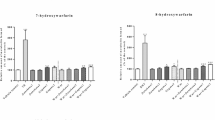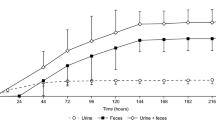Abstract
Purpose. The hydrochloride salts of the N, N-dimethylglycine esters of menahydroquinone-4 (1-mono, 1; 4-mono, 2; and 1,4-bis, 3) were assessed in vivo as prodrug for the systemic site-specific delivery system of menahydroquinone-4 (MKH), the active form of menaquinone-4 (MK-4, vitamin K2(20)).
Methods. The disposition of MK-4 and menaquinone-4 epoxide (MKO) following the intravenous administration of the prodrugs and MK-4 preparation solubilized with surfactant (H-MK-4) were studied in vitamin K cycle inhibited rats. The relative bioavailability of MKH after the administration of the prodrugs was assessed from the area under the plasma concentration of MKO vs. time curve (AUC MKO). The specific delivery of MKH to its active site (liver) and coagulation activity after the administration of selected prodrug 1 were then compared with those of H-MK-4 in warfarin poisoned rats.
Results. All compounds showed linear pharmacokinetics, and significant bioavailability of MKH was also observed following the administration of 1 (188%), 2 (87%) and 3(135%). Prodrug 1 caused the following increases; AUC liver of MKO from 70.7 ± 5.77 (H-MK-4) to 167 ± 7.89 nmol · h/g, MRT liver of MKO, from 3.87 ± 0.307 to 8.57 ± 0.432 h. The liver accumulation of intrinsic 1 reached a maximum (88% of dose) by 0.25 h. The rapid and liver-selective uptake and liver esterase mediated MKH regeneration characteristics of 1 enhanced the delivery of MKH to its active site and the selective advantage was increased 5.7 fold. The coagulation activity was extended 1.9 fold by 1 administration.
Conclusions. The results indicated that these highly water-soluble and liver-esterase hydrolyzable ester derivatives of MKH are potential candidates for parenteral prodrugs which can thus achieve the systemic site-specific delivery of MKH. Such effective and selective delivery of MKH to its active site can therefore lead to enhanced pharmacological efficacy and can also avoid the toxicity induced by the solubilizing agent used in the H-MK-4 preparation.
Similar content being viewed by others
REFERENCES
J. W. Suttie. Vitamin K-dependent carboxylase. Annu. Rev. Biochem. 54:459–477 (1985).
R. J. Riley and P. Workman. DT-diaphorase and cancer chemotherapy. Biochem. Pharmacol. 43:1657–1669 (1992).
B. K. Park, A. K. Scott, A. C. Wilson, B. P. Haynes, and H. M. Beckenridge. Plasma disposition of vitamin K1 in relation to anticoagulant poisoning. Br. J. Clin. Pharmacol. 18:655–662 (1984).
R. Wallin and L. F. Martin. Warfarin poisoning and vitamin K antagonism in rat and human liver: Design of a system in vitro that mimics the situation in vivo. Biochem. J. 241:389–396 (1987).
M. T. Smith, C. G. Evance, H. Thor, and S. Orrenius. Quinone induced oxidative injury to cell and tissues. In H. Sies (ed.), Oxidative Stress, Academic Press, London, 1985, pp. 91–113.
M. Z. Badr, H. Yoshihara, F. C. Kauffman, and R. G. Thurman. Menadione causes selective toxicity to periportal regions of the liver lobule. Toxicol. Lett. 35:241–246 (1987).
M. Z. Badr, P. E. Ganey, H. Yoshihara, F. C. Kauffman, and R. G. Thurman. Hepatotoxicity of menadione predominates in oxygen-rich zones of the liver lobule. J. Pharmacol. Exp. Ther. 248:1317–1322 (1989).
J. E. F. Reynolds (ed.), Martindale The extra pharmacopoeia. 29-th edition, The pharmaceutical press, London, 1989, pp. 1285–1287.
J. Takata, Y. Karube, M. Hanada, K. Matsunaga, Y. Matsushima, T. Sendo, and T. Aoyama. Vitamin K prodrugs 1. Synthesis of amino acid esters of menahydroquinone-4 and enzymatic reconversion to an active form. Pharm. Res. 12: 18–23 (1995).
M. J. Shearer, A. McBurney, A. M. Breckenridge, and P. Barkhan. Effect of warfarin on the metabolism of phylloquinone (vitamin K1): dose-response relationships in man. Clin. Sci. Mol. Med. 52:621–630 (1977).
Y. Haroon, D. S. Bacon, and J. A. Sadowski, Liquid-chromatographic determination of vitamin K1 in plasma, with fluorometric detection. Clin. Chem. 32:1925–1929 (1986).
K. Yamaoka, Y. Tanigawara, T. Nakagawa, and T. Uno. A pharmacokinetic analysis program (MULTI) for microcomputer. J. Pharmacobio-Dyn. 4:879–885 (1981).
K. Yamaoka, T. Nakagawa, and T. Uno. Statistical moments in pharmacokinetics. J. Pharmacokinet. Biopharm. 6:547–558 (1978).
S. Oie, D. Trenk, T. W. Guentert, H. Mosberg, and E Jahnchen. Disposition of vitamin K1 after intravenous and oral administration to subjects on phenprocoumon therapy. Int. J. Pharm. 48:223–230 (1988).
U. G. Eriksson and T. N. Tozer. Pharmacokinetic evaluation of regional drug delivery. Acta Pharm. Jugosl. 37:331–344 (1987).
Rights and permissions
About this article
Cite this article
Takata, J., Karube, Y., Hanada, M. et al. Vitamin K Prodrugs: 2. Water-Soluble Prodrugs of Menahydroquinone-4 for Systemic Site-Specific Delivery. Pharm Res 12, 1973–1979 (1995). https://doi.org/10.1023/A:1016208409992
Issue Date:
DOI: https://doi.org/10.1023/A:1016208409992




